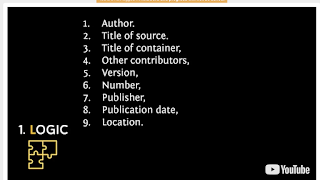What Is MLA?
MLA stands for Modern Language Association, and MLA format refers to the format the association created that is commonly used in many areas of academic writing, particularly in the humanities.
3 Components
Format - In-text Citations - Works Cited Page
3 Components
Format - In-text Citations - Works Cited Page
Formatting Your Paper The MLA Way
A properly-formatted MLA-style paper will be constructed as follows: *
- Typed on 8.5 X 11 inch paper with 12 pt. font
- 1-inch margins on all sides
- First line of each paragraph indented one half-inch from the left margin (pro tip: use the tab key instead of the space bar to ensure perfect indentation)
- Body text of the paper should be double spaced
- Only one space after periods or other punctuation marks
- Number all of your pages in the upper right hand corner - your page numbers should be a half inch from the top of the paper and in line with your right margin.
- Sorry, don't be creative with your text formatting!
In-Text Citations
Why are citations important or necessary?
* Good idea to record citation info while you are taking notes.
* Good idea to record citation info while you are taking notes.
In-text citations are important for ensuring that you properly credit your sources. *
The pieces of information you'll need to know when creating an in-text citation for your paper are:
- the name of the author (or authors) of the work you're citing and the page number on which the information you're using can be found.
Citing non-print or sources from the Internet
- When creating in-text citations for electronic, film, or Internet sources, remember that your citation must reference the source in your Works Cited.
- Include in the text the first item that appears in the Work Cited entry that corresponds to the citation (e.g. author name, article name, website name, film name).
- You do not need to give paragraph numbers or page numbers based on your Web browser’s print preview function.
- Unless you must list the Web site name in the signal phrase in order to get the reader to the appropriate entry, do not include URLs in-text. Only provide partial URLs such as when the name of the site includes, for example, a domain name, like CNN.com orForbes.com as opposed to writing out http://www.cnn.com or http://www.forbes.com.
MLA no longer requires the use of a web link when citing online sources. To cite sources using MLA, you will need the author, the date the web resource was created, the title and the date the information was accessed. If you are going to cite an entire website using MLA, it would look like this:
Editor, author, or compiler name (if available). Name of Site. Version number. Name of institution/organization affiliated with the site (sponsor or publisher), date of resource creation (if available). Medium of publication. Date of access.
For More Information :
Online MLA Style Guide Easy Bib
Modern Language Association

* What are the consequences for Plagiarism at KRHS?
Works Consulted:
Modern Language Association
Works Cited

To Cite or Not to Cite.....
Defining Plagiarism
To steal or not to steal? That is the question.
According to Merriam-Webster, 'to plagiarize is to steal and pass off the ideas or words of another as one's own.' Another definition of plagiarize is 'to use another's production without crediting the source.' While intentional plagiarism is a problem, we're going to focus on unintentional plagiarism. While it may seem improbable that someone could steal by accident, it can happen quite easily with writing!
How do I know if I need to Cite?
A good rule of thumb for determining if you need to cite a source is to ask yourself these simple questions:
1. How do I know this information? If you know this information because you learned it from someone else, then you need to cite your source.
2. Am I presenting this information as a fact? If you are presenting information as fact, you need to cite your source and give credit where credit is due.
3. When I typed this information in a search engine, did I find sources that had been published this idea? Here is where people tend to get into trouble. Sometimes we may have read information a while ago and don't quite remember where we heard it. Sometimes we assume things are common knowledge when it's really just information we have been exposed to so often, we forget it isn't simply a part of our genetic make-up. Doing a search of information you originally thought you just made up will let you realize you may have been exposed to it before. No matter how brief that exposure, you need to give credit.
* What are the consequences for Plagiarism at KRHS?
Works Consulted:





No comments:
Post a Comment